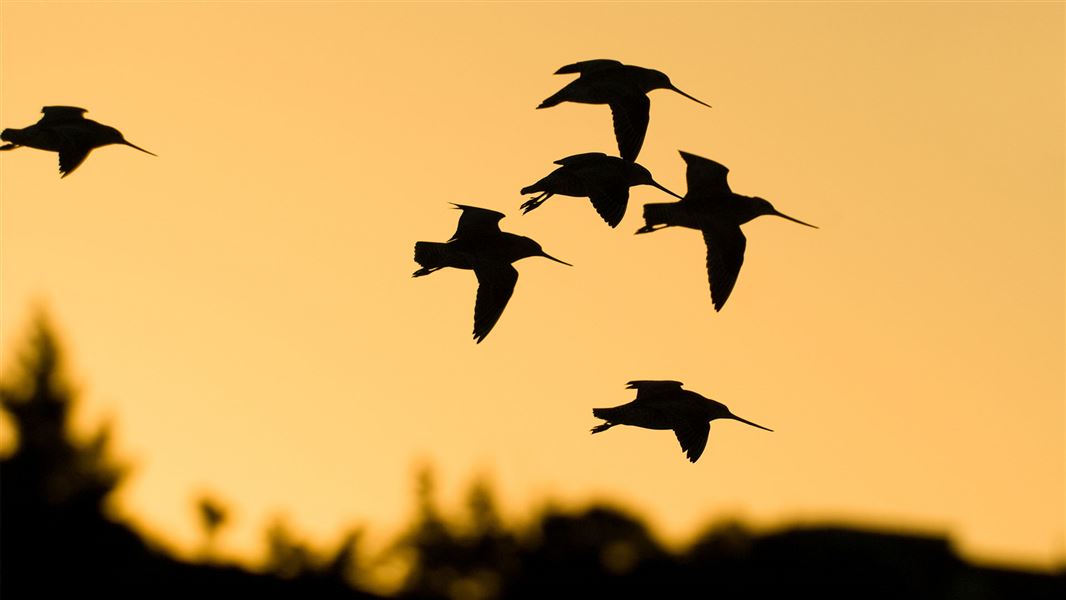Archived content: This media release was accurate on the date of publication.
Date: 23 October 2020
During its migration the adult godwit, fitted with a transmitter last November, was tracked across the Pacific Ocean, and covered more than 12,000 km in 9.3 days, touching speeds close to 100 km/hr.
The bird is named 4BBRW – after the bands on its legs – and was tracked by satellites. Its estimated flight time was 224 hours.
It left Alaska 18 September and arrived in the Firth of Thames around 9:30 pm 27 September – 9 straight days airborne.
Keith Woodley, the manager of the Pukorokoro-Miranda Shorebird Centre on the western coast of the Firth of Thames and author of a book on the species, says the bird’s astounding effort is being hailed as a record by bird watchers around the world.
“We think it’s the distance record – a bird named E7 did 11680 km back in 2007, and we think this bird has gone a bit further than that.
“He’s truly a champion. This year, in particular, it’s certainly something to lift the spirits of folks – even though we may get a bit envious of birds that don’t have to do quarantine and negotiate border controls!”
The godwits migrate from New Zealand to China in March and April. They stop over in the Yellow Sea to feed, before heading to Alaska in May and June, where they stay for several months during the Northern Hemisphere summer. They migrate back to New Zealand in September.
Keith Woodley says the tracking of 4BBRW has given an important insight into how weather conditions in the Pacific can impact on the godwits’ migration.
“We know wind is an important part of a migration strategy, and like a cyclist, they’ll try to get a tailwind if they can – but they can’t always manage it.
“This season there’s been all sorts of odd weather patterns out over the northern Pacific which has affected how the birds have gone.”
The recording of the bird’s journey has added crucial new information to wider understanding of the godwits’ migration, Keith Woodley says: “The little devices on the birds are solar-powered, and the people doing the research are expecting to get two, three maybe even four years of data if the devices keep working as they should. There’s the possibility of following an individual bird over several migration cycles, and it would be very interesting to see if they follow the same route.”
The godwits double their weight before their marathon migration, increase their red blood cells, and while on their long flights they contract their digestive system - changes which occur three times a year.
They arrive at the Firth of Thames exhausted from their journey from Alaska.
“They seem to be able to recover very quickly, but we don’t know quite how long that takes after a flight – they seem to have a very fast metabolism.
“Whether that recovery takes a matter of hours or days, we’re still trying to work that out.”
Bruce McKinlay, a Technical Advisor in the Department of Conservation (DOC) who represents DOC the East Asian-Australasian Flyway Partnership (EAAFP) says the detail provided by this tracking work is extremely important in identifying the pathways migratory birds use during migration.
“Having this detail allows for much better discussions with the nations along the flyway to promote conservation of the species.
“The EAAFP is the key multi-lateral organisation working to promote the conservation of migratory waterbirds in the East Asian-Australasian Flyway.
“Tracking results such as this are the key building blocks for engaging with partners from as far away as Alaska and Siberia to protect habitats that are essential to completing these massive migrations.”
Godwits are classified as declining due to the loss of their habitat.
Although the length of the godwits’ migration is impressive, it is not the longest in the bird world. That title is held by the tiny arctic tern, which has been tracked on a 71,000 km zig-zag migration between Greenland and Antarctica.
Contact
For media enquiries contact:
Email: media@doc.govt.nz
